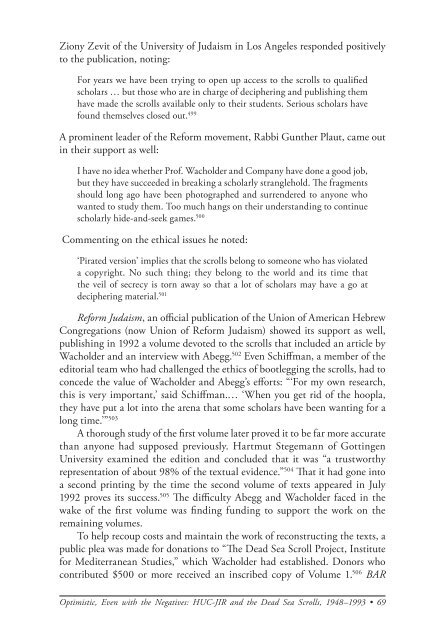The American Jewish Archives Journal, Volume LXI 2009, Number 1
The American Jewish Archives Journal, Volume LXI 2009, Number 1
The American Jewish Archives Journal, Volume LXI 2009, Number 1
You also want an ePaper? Increase the reach of your titles
YUMPU automatically turns print PDFs into web optimized ePapers that Google loves.
Ziony Zevit of the University of Judaism in Los Angeles responded positively<br />
to the publication, noting:<br />
For years we have been trying to open up access to the scrolls to qualified<br />
scholars … but those who are in charge of deciphering and publishing them<br />
have made the scrolls available only to their students. Serious scholars have<br />
found themselves closed out. 499<br />
A prominent leader of the Reform movement, Rabbi Gunther Plaut, came out<br />
in their support as well:<br />
I have no idea whether Prof. Wacholder and Company have done a good job,<br />
but they have succeeded in breaking a scholarly stranglehold. <strong>The</strong> fragments<br />
should long ago have been photographed and surrendered to anyone who<br />
wanted to study them. Too much hangs on their understanding to continue<br />
scholarly hide-and-seek games. 500<br />
Commenting on the ethical issues he noted:<br />
‘Pirated version’ implies that the scrolls belong to someone who has violated<br />
a copyright. No such thing; they belong to the world and its time that<br />
the veil of secrecy is torn away so that a lot of scholars may have a go at<br />
deciphering material. 501<br />
Reform Judaism, an official publication of the Union of <strong>American</strong> Hebrew<br />
Congregations (now Union of Reform Judaism) showed its support as well,<br />
publishing in 1992 a volume devoted to the scrolls that included an article by<br />
Wacholder and an interview with Abegg. 502 Even Schiffman, a member of the<br />
editorial team who had challenged the ethics of bootlegging the scrolls, had to<br />
concede the value of Wacholder and Abegg’s efforts: “‘For my own research,<br />
this is very important,’ said Schiffman.… ‘When you get rid of the hoopla,<br />
they have put a lot into the arena that some scholars have been wanting for a<br />
long time.’” 503<br />
A thorough study of the first volume later proved it to be far more accurate<br />
than anyone had supposed previously. Hartmut Stegemann of Gottingen<br />
University examined the edition and concluded that it was “a trustworthy<br />
representation of about 98% of the textual evidence.” 504 That it had gone into<br />
a second printing by the time the second volume of texts appeared in July<br />
1992 proves its success. 505 <strong>The</strong> difficulty Abegg and Wacholder faced in the<br />
wake of the first volume was finding funding to support the work on the<br />
remaining volumes.<br />
To help recoup costs and maintain the work of reconstructing the texts, a<br />
public plea was made for donations to “<strong>The</strong> Dead Sea Scroll Project, Institute<br />
for Mediterranean Studies,” which Wacholder had established. Donors who<br />
contributed $500 or more received an inscribed copy of <strong>Volume</strong> 1. 506 BAR<br />
Optimistic, Even with the Negatives: HUC-JIR and the Dead Sea Scrolls, 1948–1993 • 69

















